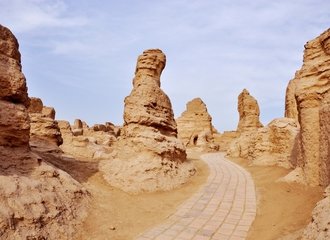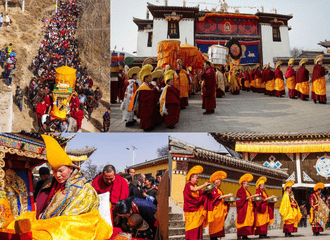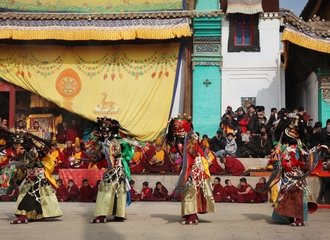Tibetan religious ceremony
Primitive Ceremony
The primitive religious ceremony focuses mainly on sacrifices, comprised of three kinds of activities: the burning of aromatic plants, blood sacrifices and dances. All three of these activities are considered indispensable on important occasions, but otherwise dancing is generally omitted.
Burning aromatic plants is a must in any case. It generally involves burning cypress or other leaves to please the deities. For blood sacrifices, offerings of animals like sheep, oxen and horses have been made to the deities. Because of the forbiddance of killing in Buddhism, this is no longer done and taken place by other ways. Chemar, a box containing Tsampa or other grains and stuck with Butter Sculptures , is the traditional offering to deities and is still popular today. Tibetans are also inclined to offer pure waters, mandalas , butter lamps, fruits, fragrant plants and jewels when worshipping. In addition, they also use embroideries, silks and other prized cloths to decorate Thangka , statues, sutras and protect the outside stupas . All of these practices are witness to their piety. The dance performed in the religious ceremony is called ' Changmo Dance ' , or 'Sorcerer's Dance'. Its purpose is to exorcise ghosts, and it is performed by lamas, wearing masks and robes decorated with colorful strips of cloths and weapons.
This primitive religious ceremony is used either in the indigenous religion, Bon or the later Buddhism in Tibet. Except for the blood sacrifice, the ceremony continues to be a local custom in the daily life of Tibetans.
Popular Religious Activities
Tibetan Buddhism has now become the dominant religion in Tibet. Average Tibetans have many religious activities to satisfy their faith, to name just a few: reciting sutras, murmuring mantras , hanging prayer flags , turning prayer wheels , circumambulating, worshipping and prostrating themselves. In the monasteries of Tibet, apart from the regular sutra reciting and debating, a religious festival will be held almost every month, which often attracts many locals to come to worship and see their performances.























